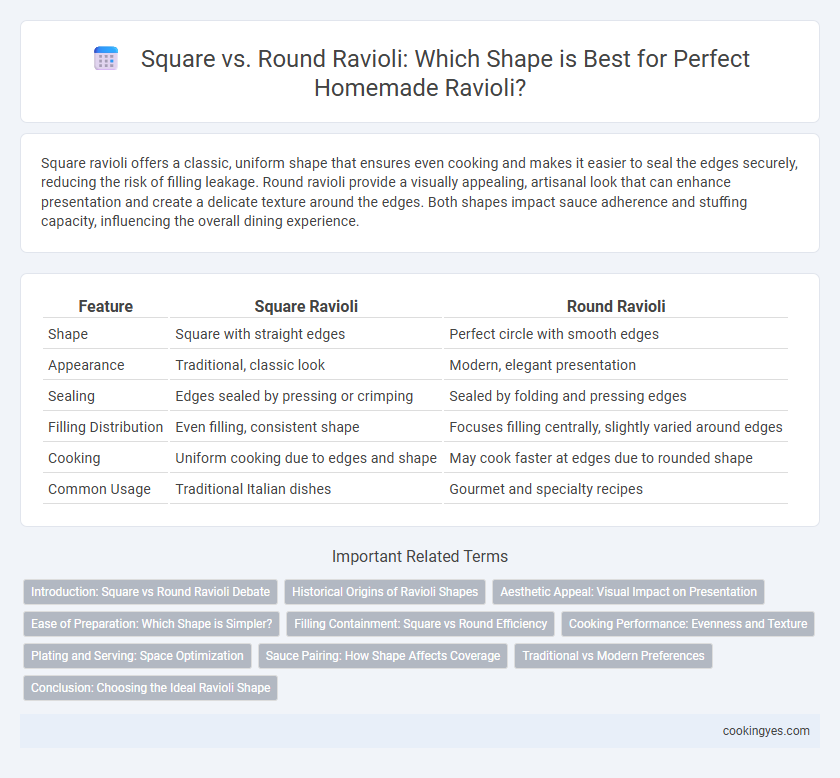Square ravioli offers a classic, uniform shape that ensures even cooking and makes it easier to seal the edges securely, reducing the risk of filling leakage. Round ravioli provide a visually appealing, artisanal look that can enhance presentation and create a delicate texture around the edges. Both shapes impact sauce adherence and stuffing capacity, influencing the overall dining experience.
Table of Comparison
| Feature | Square Ravioli | Round Ravioli |
|---|---|---|
| Shape | Square with straight edges | Perfect circle with smooth edges |
| Appearance | Traditional, classic look | Modern, elegant presentation |
| Sealing | Edges sealed by pressing or crimping | Sealed by folding and pressing edges |
| Filling Distribution | Even filling, consistent shape | Focuses filling centrally, slightly varied around edges |
| Cooking | Uniform cooking due to edges and shape | May cook faster at edges due to rounded shape |
| Common Usage | Traditional Italian dishes | Gourmet and specialty recipes |
Introduction: Square vs Round Ravioli Debate
Square ravioli offers a traditional, classic shape with crisp edges that seal filling securely, enhancing bite consistency and ease of portioning. Round ravioli provides a delicate, artisanal appearance often favored for gourmet presentations, with curved edges that improve dough-to-filling balance and reduce breakage in cooking. Both shapes influence texture and cooking results, making shape choice critical based on recipe requirements and aesthetic preferences.
Historical Origins of Ravioli Shapes
Square ravioli trace their origins to Liguria in northern Italy, where the shape was practical for sealing edges and ensuring even cooking. Round ravioli emerged later, inspired by other filled pasta varieties such as agnolotti from Piedmont, reflecting regional adaptations and culinary creativity. The diversity in shapes highlights historical influences and regional preferences in traditional Italian pasta-making.
Aesthetic Appeal: Visual Impact on Presentation
Square ravioli offer a clean, geometric appearance that enhances structured plating designs, making dishes look modern and refined. Round ravioli provide a softer, more artisanal feel that complements rustic or traditional presentations, adding a sense of handcrafted charm. Both shapes create distinct visual impacts that can elevate the overall dining experience by aligning with the desired aesthetic theme.
Ease of Preparation: Which Shape is Simpler?
Square ravioli are generally easier to prepare due to their straight edges, which simplify sealing and cutting, especially with a pasta wheel or knife. Round ravioli require more precise dough handling and specialized tools like round cutters to maintain uniformity, potentially increasing preparation time. Home cooks and beginners often find square ravioli more accessible because the straightforward shape reduces the risk of filling leakage during cooking.
Filling Containment: Square vs Round Efficiency
Square ravioli provide superior filling containment due to their straight edges and sealed corners, reducing the risk of filling leakage during cooking. Round ravioli, with their curved edges, may experience pressure points that increase the chance of filling escaping. The geometric efficiency of square shapes ensures even dough thickness and consistent sealing, optimizing filling retention compared to round variants.
Cooking Performance: Evenness and Texture
Square ravioli provide uniform edges that promote even cooking and consistent texture throughout the pasta. Round ravioli tend to have a more variable thickness near the edges, which can result in uneven cooking and slightly differing textures. The consistent shape of square ravioli enhances heat distribution, ensuring a balanced al dente finish.
Plating and Serving: Space Optimization
Square ravioli offer enhanced plating efficiency due to their uniform edges, allowing for precise alignment and maximizing available plate space compared to round ravioli. The consistent shape facilitates stacking or arranging in neat rows without gaps, ideal for serving multiple portions in limited dining areas. Round ravioli create a more artisanal presentation but require more plate space because of their curved edges and irregular placement.
Sauce Pairing: How Shape Affects Coverage
Square ravioli's flat edges create more surface area that allows sauces to adhere evenly, enhancing every bite with consistent flavor. Round ravioli, with their curved shape, tend to shed thicker, creamier sauces less easily while holding lighter, oil-based sauces better. Choosing the final shape based on sauce pairing optimizes flavor absorption and eating experience.
Traditional vs Modern Preferences
Square ravioli maintain a traditional, classic shape favored in Italian cuisine for their uniform edges and easy stacking during cooking and serving. Round ravioli represent a modern twist, often chosen for aesthetic appeal and artistic presentation in contemporary culinary settings. Traditional preferences emphasize heritage and practicality, while modern trends prioritize visual uniqueness and innovation in final plating.
Conclusion: Choosing the Ideal Ravioli Shape
Square ravioli offer uniform edges and easier sealing, enhancing consistency in cooking and filling retention, while round ravioli provide a distinctive aesthetic and can better accommodate various filling textures due to their curved shape. Chefs seeking precision and traditional presentation often prefer square ravioli, whereas those prioritizing visual appeal and creative plating lean towards round ravioli. Selecting the ideal ravioli shape depends on balancing culinary technique with desired presentation and eating experience.
Square ravioli vs Round ravioli for final shape Infographic

 cookingyes.com
cookingyes.com